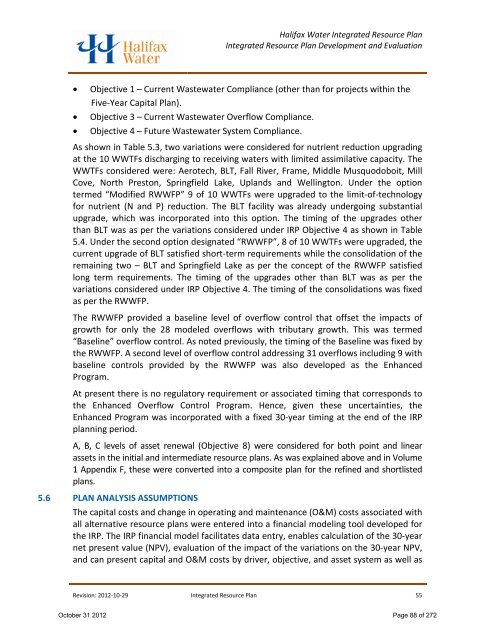volume 1 - Halifax Regional Municipality
volume 1 - Halifax Regional Municipality
volume 1 - Halifax Regional Municipality
You also want an ePaper? Increase the reach of your titles
YUMPU automatically turns print PDFs into web optimized ePapers that Google loves.
<strong>Halifax</strong> Water Integrated Resource Plan<br />
Integrated Resource Plan Development and Evaluation<br />
• Objective 1 – Current Wastewater Compliance (other than for projects within the<br />
Five-Year Capital Plan).<br />
• Objective 3 – Current Wastewater Overflow Compliance.<br />
• Objective 4 – Future Wastewater System Compliance.<br />
As shown in Table 5.3, two variations were considered for nutrient reduction upgrading<br />
at the 10 WWTFs discharging to receiving waters with limited assimilative capacity. The<br />
WWTFs considered were: Aerotech, BLT, Fall River, Frame, Middle Musquodoboit, Mill<br />
Cove, North Preston, Springfield Lake, Uplands and Wellington. Under the option<br />
termed “Modified RWWFP” 9 of 10 WWTFs were upgraded to the limit-of-technology<br />
for nutrient (N and P) reduction. The BLT facility was already undergoing substantial<br />
upgrade, which was incorporated into this option. The timing of the upgrades other<br />
than BLT was as per the variations considered under IRP Objective 4 as shown in Table<br />
5.4. Under the second option designated “RWWFP”, 8 of 10 WWTFs were upgraded, the<br />
current upgrade of BLT satisfied short-term requirements while the consolidation of the<br />
remaining two – BLT and Springfield Lake as per the concept of the RWWFP satisfied<br />
long term requirements. The timing of the upgrades other than BLT was as per the<br />
variations considered under IRP Objective 4. The timing of the consolidations was fixed<br />
as per the RWWFP.<br />
The RWWFP provided a baseline level of overflow control that offset the impacts of<br />
growth for only the 28 modeled overflows with tributary growth. This was termed<br />
“Baseline” overflow control. As noted previously, the timing of the Baseline was fixed by<br />
the RWWFP. A second level of overflow control addressing 31 overflows including 9 with<br />
baseline controls provided by the RWWFP was also developed as the Enhanced<br />
Program.<br />
At present there is no regulatory requirement or associated timing that corresponds to<br />
the Enhanced Overflow Control Program. Hence, given these uncertainties, the<br />
Enhanced Program was incorporated with a fixed 30-year timing at the end of the IRP<br />
planning period.<br />
A, B, C levels of asset renewal (Objective 8) were considered for both point and linear<br />
assets in the initial and intermediate resource plans. As was explained above and in Volume<br />
1 Appendix F, these were converted into a composite plan for the refined and shortlisted<br />
plans.<br />
5.6 PLAN ANALYSIS ASSUMPTIONS<br />
The capital costs and change in operating and maintenance (O&M) costs associated with<br />
all alternative resource plans were entered into a financial modeling tool developed for<br />
the IRP. The IRP financial model facilitates data entry, enables calculation of the 30-year<br />
net present value (NPV), evaluation of the impact of the variations on the 30-year NPV,<br />
and can present capital and O&M costs by driver, objective, and asset system as well as<br />
Revision: 2012-10-29 Integrated Resource Plan 55<br />
October 31 2012 Page 88 of 272
















